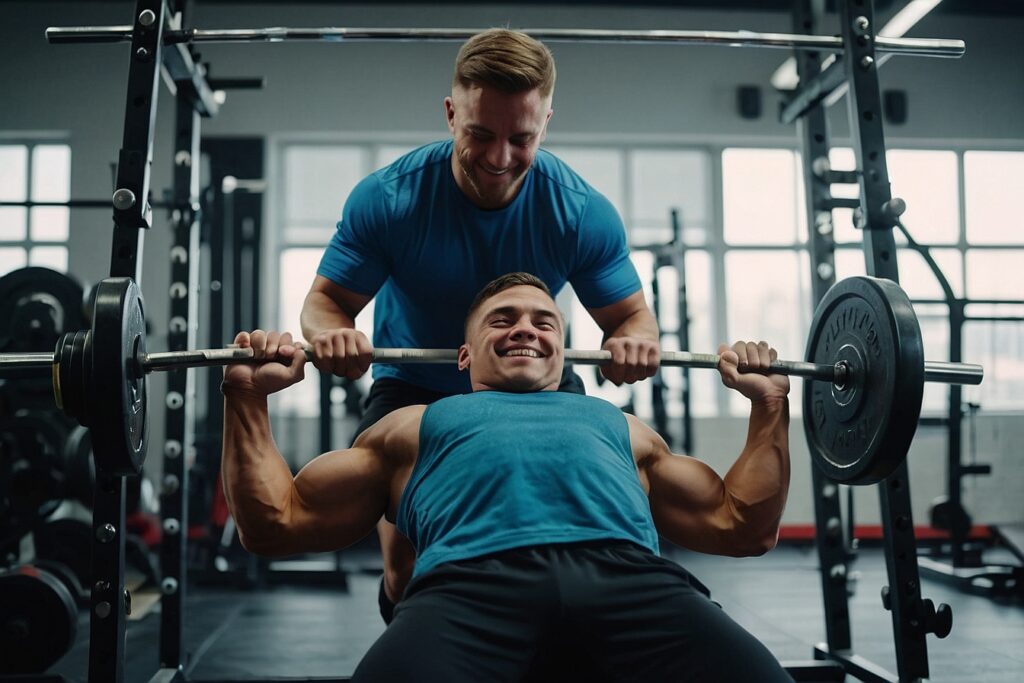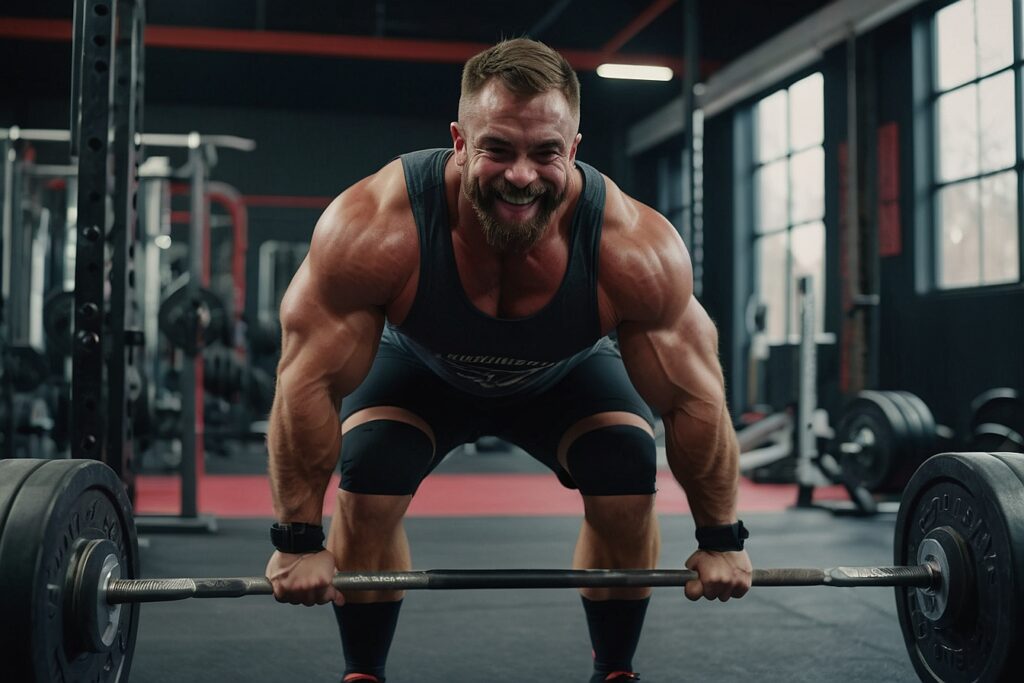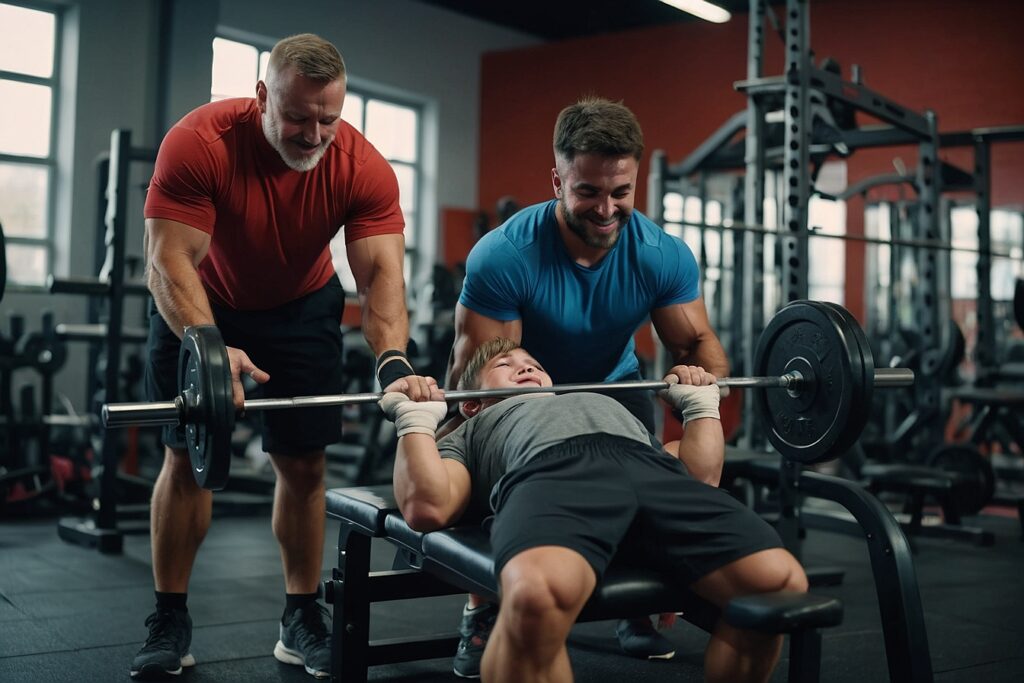Powerlifting for Beginners: A Strong Start Guide.
Welcome to our comprehensive guide of powerlifting for beginners looking to get started with powerlifting. Whether you want to improve your overall strength, train for...

Welcome to our comprehensive guide of powerlifting for beginners looking to get started with powerlifting. Whether you want to improve your overall strength, train for a competition, or just try something new, powerlifting can offer a challenging and fulfilling journey.
In this guide, we will cover essential powerlifting tips, exercises, training programs, equipment, techniques, competitions, routines, and workouts to help you begin your strength journey. Whether you’re a complete beginner or have some experience with strength training, our guide is designed to provide you with everything you need to know to get started with powerlifting.
Join us on this exciting journey as we explore the world of powerlifting and help you achieve your strength goals. Let’s get started!
Understanding Powerlifting: A Brief Overview
Powerlifting is a strength sport that involves three main lifts: squat, bench press, and deadlift. The objective of powerlifting is to lift the maximum weight possible for one repetition in each of the three lifts.
Powerlifting is a competitive sport, and lifters are classified based on body weight into different weight categories. The International Powerlifting Federation (IPF) is the governing body for powerlifting competitions globally.
The rules for powerlifting are straightforward: each lifter gets three attempts at each lift, and the highest successful lift in each lift is added together to get the lifter’s total. The lifter with the highest total in their weight class wins the competition.
Powerlifting is a challenging and rewarding sport that requires strength, technique, and mental toughness. Whether you’re a beginner or an experienced lifter, powerlifting can provide you with a sense of community, accomplishment, and personal growth. In the following sections, we will delve deeper into the essential tips, exercises, training programs, equipment, techniques, competitions, routines, and workouts to help you succeed in powerlifting.
Getting Started: Essential Tips for Beginner Powerlifters

If you’re new to powerlifting, it can be overwhelming to figure out where to start. To set you up for success, we’ve compiled a list of essential tips to keep in mind as a beginner.
1. Focus on Proper Form
It’s essential to prioritize proper form when lifting. This means performing the lifts correctly with appropriate technique. Lifting with poor form not only limits your potential strength gains but can also lead to injuries. Make sure to master the technique for each lift before increasing weight.
2. Set Realistic Goals
Powerlifting is a journey that requires patience, persistence, and hard work. To stay motivated, set realistic goals that are challenging yet achievable, and celebrate your progress along the way. Aiming to increase your weight by small increments (2.5-5 lbs) can go a long way in achieving long-term goals.
3. Find a Coach or Mentor
There’s no substitute for professional guidance when it comes to powerlifting. Having an experienced coach or mentor can provide valuable feedback, help you improve your technique, and provide a source of motivation and accountability.
4. Establish a Consistent Training Schedule
Consistency is key when it comes to powerlifting. Establish a regular training schedule that works with your lifestyle and stick to it. Training consistently helps to build a solid foundation of strength and technique, which is essential for success in powerlifting.
By following these essential tips, you’ll be on the right track towards making significant progress in your powerlifting journey.
Powerlifting Exercises for Beginners: Building a Strong Foundation

Building a strong foundation is critical to success in powerlifting. As a beginner, it’s essential to focus on mastering the proper technique for each of the powerlifting lifts, including the squat, bench press, and deadlift. In this section, we will introduce you to key exercises to help you develop strength and technique in each of these lifts.
Exercise Muscles Targeted Squat Quadriceps, glutes, hamstrings, calves, and lower back Bench press Chest, triceps, and shoulders Deadlift Hamstrings, glutes, lower back, forearms, and grip strength
Squats
The squat is often referred to as the king of all exercises, and for good reason. It engages multiple muscle groups and can help increase overall strength and power. As a beginner, it’s essential to focus on mastering the proper form before increasing weight. Here’s how to perform a proper squat:
- Start with your feet shoulder-width apart, and toes pointing slightly outward.
- Place the bar on your upper back, resting it on your traps.
- Slowly lower your body down by bending at the knees and hips.
- Keep your core tight and your chest up throughout the lift.
- Push through your heels and stand back up, extending your legs and hips.
- Repeat for the desired number of reps.
Bench Press
The bench press is an excellent exercise for building upper body strength and mass. Here’s how to perform a proper bench press:
- Lie on a bench with your feet flat on the floor.
- Grip the bar slightly wider than shoulder-width apart and unwrap the bar. Lower the bar to your chest while keeping your elbows tucked in.
- Pause momentarily at the bottom of the lift, then push the bar back up.
- Repeat for the desired number of reps.
Deadlift
The deadlift is one of the most effective exercises for building total body strength, especially in the posterior chain muscles. Here’s how to perform a proper deadlift:
- Stand with your feet shoulder-width apart, with the barbell over your mid-foot.
- Bend down and grip the bar just outside your knees.
- Keep your core tight and your chest up while standing up and lifting the bar off the ground.
- Squeeze your glutes and push your hips forward to complete the lift.
- Lower the bar back down to the ground with control.
Adding these exercises to your training routine will help you develop a strong foundation and improve your technique in preparation for more advanced powerlifting moves.
Designing a Powerlifting Training Program: From Novice to Competitor

Whether you’re new to powerlifting or looking to take your training to the next level, a well-designed training program is essential for making progress and achieving your goals. In this section, we’ll provide you with a step-by-step guide for designing a powerlifting training program that will take you from novice to competitor.
Assessing Your Current Fitness Level
The first step in designing a powerlifting training program is to assess your current fitness level. This will help you determine your starting point and set realistic goals for yourself. Some ways to assess your fitness level include:
- Perform the three powerlifting lifts (squat, bench press, and deadlift) and record your current one-rep max for each lift.
- Doing a bodyweight assessment to determine your current strength-to-weight ratio.
- Performing other fitness tests, such as the beep test, vertical jump, or shuttle run.
Setting Goals
Once you’ve assessed your current fitness level, it’s time to set goals for yourself. Your goals should be specific, measurable, achievable, relevant, and time-bound (SMART). Examples of SMART goals for powerlifting might include:
- Increase your one-rep max for squat, bench press, and deadlift by 10% in the next six months.
- Compete in a powerlifting competition within the next year.
- Improve your technique in the powerlifting lifts by attending a powerlifting seminar or working with a coach.
Choosing a Powerlifting Training Program
There are many powerlifting training programs out there, each with its own unique approach and philosophy. Some popular programs include:
- Starting Strength
- 5/3/1
- Westside Barbell
- Candito Training HQ
When choosing a powerlifting training program, it’s important to consider factors such as your goals, fitness level, time commitment, and personal preferences. We recommend trying out different programs and seeing what works best for you.
Designing Your Powerlifting Training Program
Once you’ve chosen a powerlifting training program, it’s time to design your own individualized program. This involves customizing the program to your specific needs and goals, based on your current fitness level and any limitations or injuries you may have. Some things to consider when designing your powerlifting training program include:
- Frequency of training sessions
- Intensity and volume of lifts
- Accessory exercises to target specific muscle groups
- Scheduling rest and recovery days
Progression and Periodization
As you progress in your powerlifting training program, it’s important to incorporate progression and periodization to continue making gains and avoiding plateaus. This involves gradually increasing the intensity and volume of your lifts over time, as well as incorporating weeks and other recovery strategies.
Tracking Your Progress
Finally, it’s important to track your progress throughout your powerlifting training program. This will help you stay accountable, measure your progress, and adjust your program as needed. Some ways to track your progress include:
- Keeping a training journal
- Recording your lifts and tracking your one-rep max
- Measuring your body weight and body fat percentage
- Tracking your sleep, nutrition, and recovery strategies
By following these steps and designing a well-rounded powerlifting training program, you can gradually progress from a novice lifter to a competitive powerlifter. Remember to stay consistent, stay motivated, and enjoy the journey!
Essential Powerlifting Equipment for Beginners
Powerlifting requires specific equipment to ensure effective and safe training. We’ve compiled a list of essential equipment that every beginner should have to begin their powerlifting journey.
Equipment Description Squat Rack A sturdy rack that can hold a loaded barbell for safe squats and other exercises. Look for one with adjustable heights and safety pins. Barbell A thick, supportive belt is worn during heavy lifting to provide stability and reduce the risk of injury. Look for one made of leather with a buckle or lever closure. Plates Metal plates that are loaded onto the barbell for added weight. Beginners should start with a set of two 45 lb. plates, two 25 lb. plates, and two 10 lb. plates. Weightlifting Belt A thick, supportive belt worn during heavy lifting to provide stability and reduce the risk of injury. Look for one made of leather with a buckle or lever closure. Supportive Gear Equipment like knee sleeves, wrist wraps, and lifting shoes can provide added support and improve performance. These items are optional but can be beneficial for serious lifters.
Investing in quality equipment can help you train more effectively and reduce the risk of injuries. Make sure to choose equipment that suits your needs and budget to get the most out of your powerlifting journey.
Mastering Powerlifting Technique: Tips for Proper Form
As a beginner powerlifter, mastering proper technique is essential to progress safely and effectively. Without proper form, you risk injury and limit your strength gains. In this section, we’ll provide you with valuable tips and cues for each of the powerlifting lifts to help you master your technique.
Squat
The squat is a compound multi-joint movement that targets your lower body, especially your quads, glutes, and hamstrings. To execute a proper squat, follow these tips:
- Place your feet shoulder-width apart with toes pointed slightly outward.
- Lower yourself by bending your hips and knees simultaneously, while keeping your chest up and your back straight.
- Pause at the bottom of the squat before reversing the motion to standing position.
- Make sure to initiate and finish the movement with your hips.
Bench press
The bench press targets your chest, shoulders, and triceps. To perform a proper bench press, follow these tips:
- Position your body on the bench with your feet firmly on the ground and your head, shoulders, and buttocks in contact with the bench.
- Make sure to have a tight grip on the bar with your hands shoulder-width apart.
- Lower the bar to your chest, keeping your elbows tight to your body.
- Pause at the bottom of the lift before pushing the bar upward with maximum force.
Deadlift
The deadlift targets your lower and upper back, glutes, and hamstrings. To perform a proper deadlift, follow these tips:
- Position your feet hip-width apart with the bar over the middle of your feet.
- Place your hands shoulder-width apart, outside your knees.
- Keep your back straight and squeeze your shoulder blades together while pulling the weight off the ground.
- Push your knees back while extending your hips and straightening your knees.
Remember, technique is king in powerlifting. Take the time to perfect your form and never sacrifice it for heavier weights. Your strength gains will thank you.
Powerlifting Competition: What You Need to Know
If you’re ready to take your powerlifting training to the next level and compete, there are a few key things you need to know. Powerlifting competitions are typically divided into weight classes, with male and female divisions.
Competitors perform three lifts: squat, bench press, and deadlift. Each lifter has three attempts at each of the three lifts, and the most successful attempt at each lift is added together to give a total score.
It’s important to familiarize yourself with the rules of the competition before signing up, as each competition may have specific requirements and guidelines. For example, some competitions may require you to wear specific lifting gear, such as a singlet or wrist wrap.
Mentally and physically preparing for a competition is crucial. It’s important to focus on your training program leading up to the competition, ensuring you’re hitting your lifts and making progress. Practicing visualization techniques and incorporating breathing exercises can also help calm your nerves and improve focus on the big day.
On competition day, arrive early to give yourself plenty of time to warm up and get in the right mindset. It’s important to remain calm, focused, and confident heading into your lifts. And remember, at the end of the day, powerlifting is all about celebrating your own personal bests and achievements.
Developing a Powerlifting Routine: Balancing Volume and Intensity
Creating a powerlifting routine is crucial for making progress and achieving your goals. When developing a routine, it’s essential to find a balance between volume and intensity to avoid burnout and injury. Here are some tips for creating a well-rounded routine:
Structure your Training Sessions
Begin each session with a dynamic warm-up to prepare your body for the workout. Choose one of the powerlifting lifts as your primary lift for the day and work on variations and accessory exercises that target specific muscle groups. Aim to increase the weight or reps gradually and regularly to avoid plateauing.
Balance Volume and Intensity
Volume refers to the total number of sets and reps you do in a session, while intensity measures the amount of weight you lift. As a beginner, focusing on higher volume with lighter weights can help you build a foundation of strength and improve your technique. As you progress, gradually increase the intensity by lifting heavier weights with fewer reps to challenge your muscles.
Incorporate Accessory Exercises
Accessory exercises are movements that target specific muscle groups used in the powerlifting lifts. Incorporating these exercises into your routine can help you improve weak points and develop strength overall. Some common accessory exercises include lunges, pull-ups, and rows.
Powerlifting Routine Example Explanation Monday: Squat Day Warm-up with bodyweight squats and lunges. Do 5 sets of 5 reps of back squats, gradually increasing the weight each set. Follow with 3 sets of 8-12 reps of front squats, leg presses, and calf raises as accessory exercises. Wednesday: Bench Press Day Warm-up with push-ups and dumbbell chest presses. Do 5 sets of 5 reps of bench press, gradually increasing the weight each set. Follow with 3 sets of 8-12 reps of incline bench press, chest flys, and tricep extensions as accessory exercises. Friday: Deadlift Day Warm-up with bodyweight squats and hip thrusts. Do 5 sets of 5 reps of deadlifts, gradually increasing the weight each set. Follow with 3 sets of 8-12 reps of Romanian deadlifts, bent-over rows, and chin-ups as accessory exercises.
Remember to give your body time to recover between workouts and listen to your body’s cues. If you feel excessively sore or fatigued, it may be time to adjust the volume or intensity of your routine. By following these guidelines, you’ll be able to create a powerlifting routine that suits your needs and helps you achieve your goals.
Conclusion
We hope this guide has provided you with valuable insight into powerlifting for beginners. With the tips, exercises, training programs, equipment, techniques, competitions, routines, and workouts we’ve covered, you’ll have the knowledge and tools to start your strength journey successfully.
Remember, powerlifting is a challenging sport that requires dedication, discipline, and hard work. But with the right mindset and approach, you can achieve significant strength gains and reach your full potential.
Whether you want to compete or simply improve your strength, powerlifting can be a great way to challenge yourself physically and mentally. So don’t hesitate to start your powerlifting journey today, and take your lifting to new heights!
Thank you for reading, and we wish you all the best in your powerlifting endeavors!
What's Your Reaction?
















